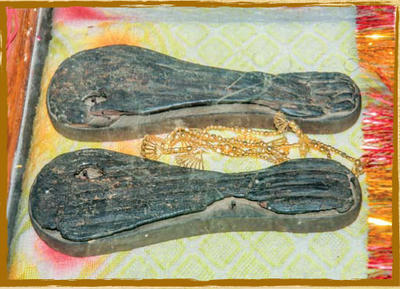Nirgun Poems: Devotion to the Formless Divine
KABIR’S POEMS INVITE US TO RETHINK OUR ideas of devotion and of God. While affirming some traditional aspects of worship, he decimates others. This epigram draws out two basic aspects of Kabir’s bhakti: all-inclusivity, and God as protector.
So I’m born a weaver, so what?
I’ve got the Lord in my heart.
Kabir: secure in the arms of Ram,
free from every snare.
Adi Granth, sakhi 82; Hawley and Juergensmeyer 2004: p. 58
The first line suggests the non-importance of jati in the world of devotion, and the following two lines underscore the principle. Kabir makes a brazen statement about his profession that denotes jati. His mention of being born a weaver problematizes the idea that one’s birth determines one’s religious status. The indication here is that bhakti is an active choice rather than a matter of birth or legacy; it is something that one has to cultivate. His nonchalant tone conveys a bold stance: bhakti should be accessible to all. But there is a prerequisite, which is to have the lord in one’s heart. Kabir states that as long as one is truly devoted to Ram, he or she is a devotee. The fact that Kabir lived and spoke out against orthodoxy in 15th century Varanasi, where Brahmin priests played a crucial role in society, makes the poet-saint’s provocation all the more powerful.
The second half of the poem demonstrates the fruits of devotion in the form of divine protection. Having God as protector or guardian is a common theme in bhakti literature, and it is this sentiment that is reflected in Kabir’s epigram. Hindu Deities such as Shiva, Vishnu, Durga and Hanuman are known for their protecting disposition, and the list includes Lord Rama. The image in Kabir’s poem of being “secure in the arms of Ram” conveys the notion that once devoted to God, the devotee will be taken care of, “free from every snare.” Kabir’s use of corporeal imagery is intriguing as the “heart” and “arms” indicate the physicality associated with bhakti, as well as the sagun (“with qualities”) nature of God. This reminds us of the body-mind argument raised by the issue of jati in the first half of the epigram, in which Kabir advocates mind over matter, although in this instance, imagery concerning the body is used in a positive context.
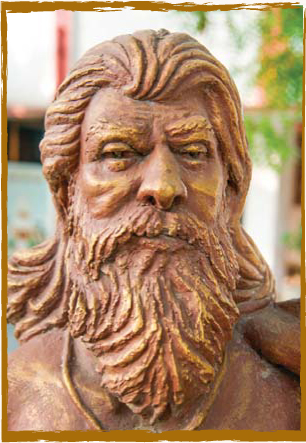
ALL PHOTOS: ARUN KUMAR MISHRA—DINODIA
An earnest quest: Kabir in bronze, one of numerous sculptures adorning the grounds of Kabir Chaura Math depicting Kabir’s story and the history of the math
Nirgun God
Kabir uses his words to intimate the formless divine that lies beyond words. Nirgun (literally, “without attributes”) names the view that God cannot be positively conceived and should not be worshiped through images or other visual forms (Hawley and Juergensmeyer 2004: p. 230). In this way, God can be interpreted as “the One,” “the All,” and “knowledge without duality,” which is the facet of the Divine that Kabir refers to in the following couplet:
The One is one with the All,
the All is one with the One.
Kabir is one
with the knowledge without duality.
sakhi 272 / Dharwadker 2003: p. 184
Here Kabir states that the One, referring to nirgun God, is the essence that permeates the All in the world of externalities. In his cryptic and laconic style, he emphasizes that it is human beings who have to realize this oneness just like Kabir did. The idea of “knowledge without duality” is indicative of 8th Adi Shankara’s advaita (nondualist) philosophy, in which Brahman (cosmic being) and atman (individual soul) are viewed as one. This is a case where similar ideas that were earlier limited to Sanskrit philosophy are being opened up to people at large through easily accessible languages. This is a key trait of the bhajans of India’s vernacular poet-saints. In other poems Kabir is more direct in his language and style. In a poem from the Kabir Granthavali, he says, “He’s Brahman: unmanifest, unlimited. He permeates everything as absolute knowledge” (Dharwadker 2003: p. 148).
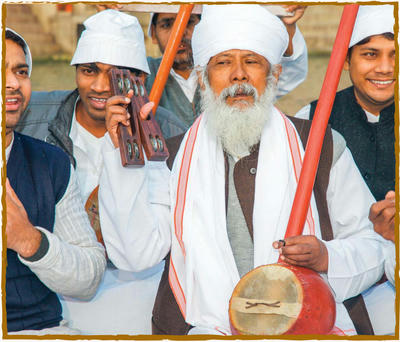
Vivek Das (center), head of the math, singing bhajans with devotees
Although we have encountered two poems that conceptualize the Divine in abstract terms, there are other ways that Kabir played with the concept of nirgun. For example, there are two poems in the Adi Granth in which God is personified as the bridegroom who has come to take away his bride, the spiritual seeker, in marriage. Kabir says, “I will walk around the fire with Ram Rai, my soul suffused with His color” and “Ram, my husband, has come to my house,” (Dass 1991: p. 8-9). The poet has used the motif of unity in marriage as an analogy for spiritual unity, an idea that Guru Nanak also adopts in some of his poetry. Although the portrayal of the Divine appears to be sagun (with qualities) in this context, the poetry does not describe specific personality traits or physical form and hence can still be characterized as nirgun in spirit. In addition to demonstrating a novel way in which the nirgun God can be represented, these poems create room for speculation about the intertextuality between the works of Kabir and other poet-saints such as Nanak, wherein Kabir’s poems may have directly influenced Nanak’s works.
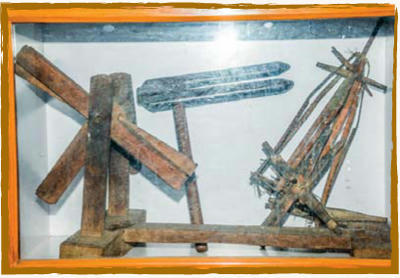
A lasting legacy: One of several artifacts from Kabir’s life, a 500-year-old wooden weaving device called charkha
Challenging Orthodoxies
Kabir often stressed the shortcomings of established Indian religiosity, usually that of popular Hinduism and Islam. For instance, he mockingly called out to siddhas (Hindu adepts) and pirs (Sufi masters) to expose their hypocrisies. However, one should be wary of interpreting his words as encouraging religious unity between the two faiths, as this was hardly his agenda. Rather than building a bridge between the two, he condemned the follies, rituals and orthodoxies of both—following a facet of nirgun theology that questions all worship of form. Instead of solely criticizing organized traditions, his poetry reflects his personal idea of transcendence of all conventional religious practices. This could be why Kabir is often categorized as a mystic rather than a saint, with the attending religious associations.
In the following poem from the Adi Granth, Kabir not only questions the significance of religious structures, both ideological and physical, but also the role and authority of leaders such as priests (mullah in Persian/Urdu).
Broadcast, O mullah, your merciful call to prayer—
you yourself are a mosque with ten doors.
Make your mind your Mecca, your body the Ka’aba—
your Self itself is the Supreme Master.
In the name of Allah, sacrifice your anger, error, impurity—
chew up your senses, become a patient man.
The lord of the Hindus and Turks is one and the same—
why become a mullah, why become a sheikh?
Kabir says, brother, I’ve gone crazy—
quietly, quietly, like a thief, my mind has slipped into the simple state.
(Adi Granth, Raga Bhairava, shabad 4)
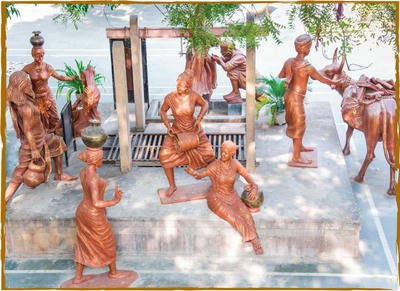
ALL PHOTOS: ARUN KUMAR MISHRA—DINODIA
Centered around an ancient well, an array of eight bronzes depicting scenes from history, including Kabir fetching water, ladies at the well, and Pandit Sarvanand arriving to debate with the poet, his bull loaded with dozens of books
The vivid Islamic imagery in this poem—mullah, call to prayer, mosque, Mecca, Ka’aba, Allah, sheikh—serves as the backdrop for Kabir’s rejection of orthodox practices. In my reading, the crux of the poem is in the second stanza, where Kabir says, “Make your mind your Mecca,” an indication to seek spirituality within rather than in external structures. It suggests that a person’s mind should be pure and serve as the holy place of worship, not to mention that the relevant journey is considered to be more mental than physical. The corporeal imagery carries over to the second line of the stanza and beyond, where the human body is compared to the sacred Ka’aba. This is an extension of “you yourself are a mosque with ten doors.” This can be interpreted as a reference to Hindu theology in which the human body is believed to possess ten faculties (indriyas) at its gross level, consisting of five faculties for action (karma indriyas): grasping, moving, speaking, eliminating and procreating; and five for perception (jnana indriyas): seeing, hearing, smelling, tasting and feeling. These could be the ten doors Kabir is referring to, as the human being is thought of as a building with ten doors in traditional yoga philosophy. Moreover, “your Self itself is the Supreme Master” is likely an indication to the concept of Brahman, and hence Vinay Dharwadker has chosen to capitalize the word “Self” in the English translation. In this poem, Kabir uses the name Allah in suggesting reform. In other poems, he uses the name Ram to appeal to his fellow men to give up base emotions, such as anger, and adopt a more spiritual lifestyle. Given the largely Hindu socio-cultural context of 15th century Varanasi and the hub of Brahmanical orthodoxy that it was, it is evident why Ram was more appealing than Allah, thus explaining Kabir’s choice. The lines “The lord of the Hindus and Turks is one and the same” refer to God as Supreme Master, untainted by sectarian or religious structures. This is a marker of nirgun poetry, in addition to the focus on interiorization (seeking God inward) rather than grosser externalities. The phrase “I’ve gone crazy” in the last stanza is reminiscent of the Sufi concept of wajd (spiritual ecstasy), and it is not surprising that today Sufi qawwali singers almost always include Kabir poetry in their repertoire. The key word in the final line of the poem, “my mind has slipped into the simple state,” is simple. We can interpret Kabir’s words to mean that everything that he has mentioned in the poem is simple, and the practice of religion can be simple as well. The overarching question is: are man-made religious orthodoxies simple? On the other hand, Kabir’s emphasis on craziness could suggest the opposite of simple. The last line could also be tongue in cheek, where Kabir is referring to the naivety of a simplistic outlook.
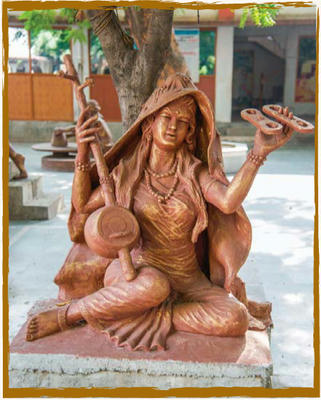
ARUN KUMAR MISHRA—DINODIA
In the bhakti tradition: A bronze of Mirabai at the Kabir Chaura Math, the 16th century singer/poetess and devotee of Krishna
In confronting the ideas of religious orthodoxy, Kabir draws from the vocabulary of both traditions to communicate his stance: God does not live in temples or mosques, but within one’s own body, mind and soul. But was Kabir a Ram bhakta, since he mentioned Ram in his poems? The poet uses “Ram” as a synonym for Truth or inner experience, and as a goal that one should meditate on and strive toward. Despite not referring directly to the Deity Rama of Ayodhya, the word has strong Hindu connotations.

UNKNOWN
An artist’s depiction of Kabir, the weaver, seated on a veranda contemplating the universe while selling his freshly made linens
The Kabir Lineage & Institutions
THE TWO KABIR MATHS IN VARANASI, AS well as those in other cities in India, are facilities through which the poet-saint’s teachings are kept alive and current, with dedicated spaces and committed monks and leaders who spread Kabir’s messages to people today. These centers are run by Kabir Panthis, a religious sect of Kabir followers who attempt to live the social and religious ideology embodied in his teachings. They are strict vegetarians and refrain from alcohol, and often tobacco. The Kabir Panth traces its lineage back to Kabir himself. According to Kabir Panthi lore, four of Kabir’s direct disciples founded four distinct branches of the Panth, with Shruti Gopal Saheb establishing the Kabir Chaura Math (considered the mul gaddi, original seat) in Varanasi, with others in Madhya Pradesh and Bihar. Today the Kabir Panth is a large fellowship, with various branches and sub-sects, which do not always see eye to eye, except when it comes to revering the Bijak, which they all regard as their primary scripture. The Bijak, an anthology of Kabir’s verses compiled in Eastern Uttar Pradesh and/or Bihar, is one of Kabir’s most influential works.
The largest Kabir math in Varanasi is built around Kabir’s legendary place of origin, including the famous pond at Lahartara where the infant Kabir was found. The Kabir Math Lahartara houses the senior monks and hosts grand events every year. The second Kabir math is Kabir Chaura, regarded as the official headquarters of the Kabir Panthis. The current head of the Kabir Chaura Math is Acharya Vivek Das, the 24th teacher in the lineage (kabirchaura.com/index.htm). This math houses the Bijak Mandir, a name apt for a temple dedicated to Kabir.
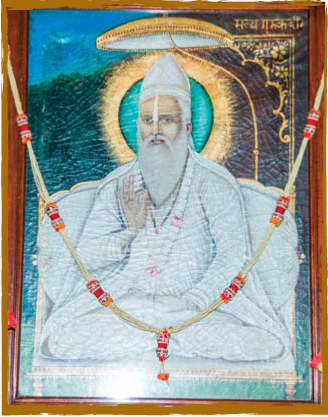
ALL PHOTOS: ARUN KUMAR MISHRA—DINODIA
Focused on God: A portrait of Kabir inside the Samadhi Mandir sanctum at Kabir Chaura Math
There are various personal artifacts displayed at the Kabir Chaura Math, which the Panth considers to have been Kabir’s own. One such item is Kabir’s khadau (sandals), and others include the mala his guru, Swami Ramananda, is said to have given him, and his weaving machine, all of which visitors can see. There are also many spaces to visit within the kabir maths. These include the Lahartara pond, Samadhi Mandir, Kabir hut, Neeru Teela (Neeru Hill) and the Sadguru Kabir Pustakalaya (library), which holds selected manuscripts of the works on Kabir and other saints.
Each of these places is associated with a popular Kabir legend, may it be Kabir’s birth narrative at the Lahartara pond or the story of Neeru and Neema (the Muslim weavers who brought Kabir up) with the Neeru Teela, where the adoptive parents’ remains are buried.
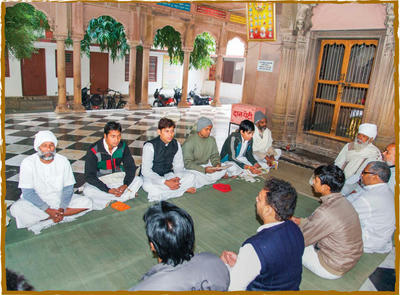
Evening satsang in the temple
Today, in addition to being a site frequented by tourists, pilgrims, and Kabir enthusiasts, the maths remain active as places of learning. The Kabir Chaura Math propagates Kabir’s philosophy via publications by its in-house press Kabirvani Prakashan Kendra, as well as through acharyas giving lectures and performing bhajans of the poet-saint. Visitors are encouraged to meditate, surround themselves in nature, and reflect on Kabir’s verses at the maths.
The material structure of the Kabir Chaura Math, with its many spaces including kabir ka ghar (Kabir’s home), physicalizes the significance and remembrance of this poet-saint. Kabir Jayanti (birthday of Kabir) is celebrated every year as a central festival, and attended by several followers of Kabir.
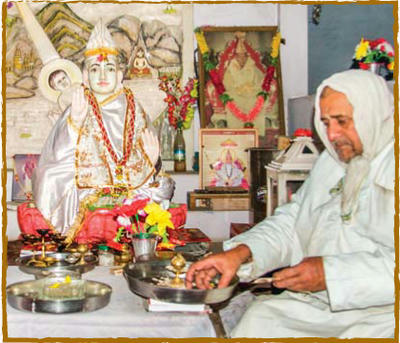
ARUN KUMAR MISHRA—DINODIA
The Kabir heritage: Priest Shri Balu Bhai inside the meditation room at the Kabir Lahartara Temple, located near the site where the infant Kabir was discovered by Neeru and Neema, who raised him as their own
In addition to celebrating Kabir, his life and works, the Kabir Chaura Math also glorifies those who followed his teachings, respected him or otherwise showed commitment to Kabir. For example, among more than a dozen life-size bronzes, there is a statue of Shruti Gopal Saheb, formerly known as Sarvanand, a Brahmin pandit from South India. Despite visiting Kabir to prove his intelligence, he eventually became Kabir’s disciple and is believed to have been appointed by Kabir to lead the Kabir Panth in Varanasi. There is also a bronze of Gandhi at Kabir Chaura, which commemorates his visit to the Math in 1934. These statues of devotees and followers are displayed alongside kiosk signs sharing the history and stories with visitors. One source claims there are nine million adherents to the Kabir Panth.
Champion of the Downtrodden
THE WORDS OF KABIR RELATE MOST DIRECTLY TO the common man, the disadvantaged section of society, the marginalized communities that face struggles and discrimination based on financial status, jati, creed and gender. He demonstrates in his poetry a revolutionary attitude toward the rulers of his society in favor of the common community.
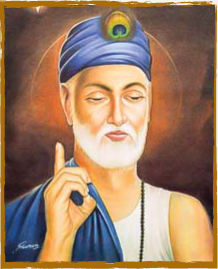
SHARAN
A modern reproduction of a vintage painting of Kabir sitting with Muslim visitors who have brought offerings of pomegranates and bananas
Sant Kabir has several times said that God is much closer to the poorest of the poor, who are open-hearted, honest and dedicated towards their life, than to so-called religious people who have created the myth that only they can afford God’s blessings through their resources. His dedication to uplifting the poor and the humble relates directly to the social service work to which my life is devoted. His attitudes in this regard stem from his own early life, growing up in a community of poor handloom weavers. He spoke boldly against the religious orthodoxy of his day, preaching respect for everyone, without discrimination, and arguing that all places are equally holy if your heart is transparent, open, sensitive and service oriented.
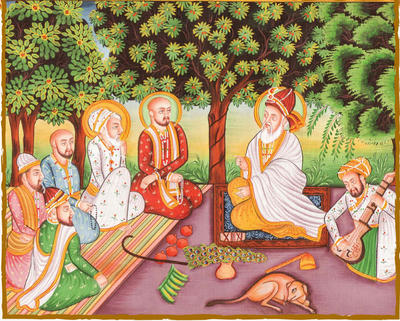
ARTNINDIA.COM
A painting of the poet wearing a turban adorned with a peacock feather
Couplets from the Bījak
If you know you’re alive,
find the essence of life.
Life is the sort of guest
you don’t meet twice. 10
The three worlds are a cage,
virtue and vice a net.
Every creature is the prey,
and one hunter:
Death. 19
Color is born of color.
I see all colors one.
What color is a living creature?
Solve it if you can. 24
Who recognizes Ram’s name,
the bars of his cage grow thin.
Sleep doesn’t come to his eyes,
meat doesn’t jell on his limbs. 54
The best of all true things
is a true heart.
Without truth no happiness,
though you try
a million tricks. 64
So what if you dropped illusion?
You didn’t drop your pride.
Pride has fooled the best sages,
pride devours all. 140
The mind: a mad killer-elephant.
The mind’s desires: hawks.
They can’t be stopped by chants or charts.
When they like, they swoop and eat. 145
From good company, joy.
From bad company, grief.
Kabir says, go where you can find
company of your own kind. 208
Three men went on pilgrimage,
jumpy minds and thieving hearts.
Not one sin was taken away;
they piled up nine tons more. 214
Do one thing completely, all is done;
try to do all, you lose the one.
To get your fill of flowers and fruit,
water the root. 273
A sweet word is a healing herb,
a bitter word is an arrow.
Entering by the door of the ear
it tears through the whole body. 301
If you’re true, a curse can’t reach you
and death can’t eat you.
Walking from truth to truth,
what can destroy you? 308
Dying, dying, the world keeps dying,
but none knows how to die.
No one dies in such a way
that he won’t die again. 324
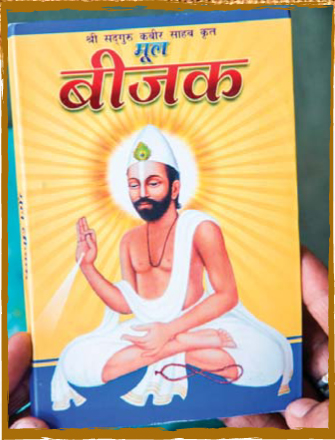
ARUN KUMAR MISHRA—DINODIA
Source/references:
Hess, Linda, and Sukhdev Singh. The Bijak of Kabir. San Francisco: North Point, 1983.

DAVID TRATTNIG
Prahlad Singh Tipanya (with tambura) in concert, dedicated to spreading Kabir’s message of oneness
Poet’s Praise
“Singing Kabir is always an uplifting experience. Kabir, the no-nonsense mystic poet, talks of yoga (awakening of the kundalini) as the only way to reach God/higher planes of existence. His singular message of looking inwards and finding the entire universe there is timeless. I no longer feel compelled to enter big temples or other such holy places, which have become commercial business hubs under the garb of religion. Kabir’s message of doing away with discrimination of all kinds is still relevant today in an era rife with religious-social hatred and global terrorism. Kabir brings me peace and hope. He is a guiding light for my spiritual journey.”
Pushkar Lele, Hindustani classical vocalist who specializes in Kabir and sings in the style of the legendary Kumar Gandharva
(www.pushkarlele.com)
“To me, Kabir’s appeal comes from the fact that you cannot place a finger on his affiliation with just one religious tradition. He personifies the nature of life, with its lack of clearly defined boundaries. Today we live in a world where people function as fluid entities more than ever before, and in this current context his appeal is great. From a musical standpoint, he speaks to that part of my identity that seeks to create outside borders. His ideology complements artistic identities that incorporate a myriad of influences.”
Aks (Ashwin Subramanian), Indian-American composer and vocalist who features Kabir extensively in his albums and live shows of contemporary devotional music (www.akscomposer.com)
Bibliography & Acknowledgements
Dass, Nirmal. Songs of Kabir from the Adi Granth. Albany: State U of New York, 1991.
Dharwadker, Vinay. Kabir: The Weaver’s Songs. New Delhi, India: Penguin, 2003.
Hawley, John Stratton, and Mark Juergensmeyer. Songs of the Saints of India. New York: Oxford UP, 2004.
Hawley, John Stratton. Three Bhakti Voices: Mirabai, Surdas, and Kabir in Their Time and Ours. New Delhi: Oxford UP, 2005.
Hess, Linda. Bodies of Song: Kabir Oral Traditions and Performative Worlds in Northern India. New York: Oxford UP, 2015.
Hess, Linda. Singing Emptiness: Kumar Gandharva Performs the Poetry of Kabir. London: Seagull, 2009.
Hess, Linda. Three Kabir Collections: A Comparative Study. The Sants: Studies in a Devotional Tradition of India. Ed. Karine Schomer and W. H. McLeod. Berkeley, CA: Berkeley Religious Studies Series, 1987.
Hess, Linda, and Sukhdev Singh. The Bijak of Kabir. San Francisco: North Point, 1983.
Keay, Frank Ernest. Kabir and His Followers. Calcutta: Association (Y.M.C.A.), 1931.
Lorenzen, David N. Kabir Legends and Ananta-das’s Kabir Parachai. Albany: State U of New York, 1991.
Lorenzen, David. The Kabir Panth. The Sants: Studies in a Devotional Tradition of India. Ed. Karine Schomer and W. H. McLeod. Berkeley, CA: Berkeley Religious Studies Series, 1987: 281-304.
Lorenzen, David N. “The Life of Kabir in Legend” Who Invented Hinduism: Essays on Religion in History. New Delhi: Yoda, 2006.
Ramanujan, A. K. The Collected Essays of A.K. Ramanujan.
Vaudeville, Charlotte, and Harry B. Partin. “Kabir and Interior Religion.” History of Religions 3.2 (1964): 191-201.
Special Acknowledgement: Dr. Rajani Kant Director/General Secretary Human Welfare Association, Varanasi (www.hwavaranasi.in),
was instrumental in our photo shoot at the two Kabir maths in Varanasi.
Where to Place Kabir?
An Interview with Professor John Stratton Hawley, Barnard College, Columbia University, New York, Conducted by Archana Nagarajan
WHAT IS YOUR TAKE ON KABIR’S HINDUNESS? The Sikhs claim him, the Muslims also. While his God certainly transcends the proprietary claims of faiths, it seems to us he stood most firmly on Hindu soil. Would you comment? JH: One of the striking things about Kabir is that in a certain cluster of very well-known poems he sets Hindus and Muslims opposite to one another, rhetorically speaking—what the qazi does wrong and what the pundit does wrong. And those “wrongs” look an awful lot alike. So I find it pretty hard to locate Kabir as standing on either side of the fence. What he’s really saying is: There is no fence! Or if you think there is a fence, well, I don’t care about it very much.

You mention the Sikhs. We have a story about how Kabir met Baba Nanak in Banaras—a great story, but I’m skeptical that any such meeting happened in historical time. Certainly we don’t have anything in Kabir’s poetry that reveals an awareness of Sikh teaching as such. And yet it’s crucially important that the Sikhs were among the first to collect Kabir’s poems and set them down on paper—in 1604 in the Kartarpur Bir, which formed the backbone of the Guru Granth. He also appears in the Goindval Pothis, which may have been composed as early as the 1570s, though we have no dated manuscripts. That’s early! If what would make Kabir Hindu is that Hindus have embraced him—which by all means they have—then we’d have to make him Sikh by the same token.
So I’m worried about calling Kabir Hindu or Sikh—or Muslim, for that matter. I think he would rebel. But what about Vaishnava? There you could make a case. Maybe you think of that as a subset of “Hindu,” but as it relates to Kabir, I wonder. At least, I don’t think that’s how he thought about things.
Think of all those poems where he intones the name of Ram. There’s nothing in his poetry to suggest that he cares at all about the Ramayana—he never tells any part of that story, so far as I know—and yet: Ram! Ram as the name of the place where Kabir takes refuge. I’ve just been putting together an essay entitled “Can There Be a Vaishnava Kabir?” In the end I think we have to say yes to that. How can we not? There are poems in the first dated text that gives us access to Kabir—the 1582 anthology from Fatehpur, which especially features Surdas—and they just don’t make sense if you try to get rid of the names of Krishna that appear there, Madhav or Banvari. If these poems belong to Kabir—and I can’t see how we can cast them out—then he has to be a Vaishnava.
But what is this Vaishnavism? It’s a sort of “vulgate” Vaishnavism—a very big-tent Vaishnavism. It makes us stand outside the yard that we usually think of as being bounded by a Vaishnava fence. That’s where Kabir’s Ram is: beyond any fence.
So is Kabir Hindu? I guess I’d like to turn that question on its head. I’d ask not whether Kabir fits the Hindu mold, but whether we can think of Hinduism in somewhat different terms than we usually do. This kind of Hinduism would have to be a religion eager to embrace Kabir without denying that Muslims and Sikhs have a perfect right to do so at the same time.
AR: Professor, you know Hindi and have encountered his works more directly than most of our readers will be able to. How would you characterize his vernacular? Was he a Shakespeare? An Omar Khayam? A Kahil Gibran? Please compare his linguistic style with poets and songwriters we know.
JH: Well I’ll tell you what comes to mind: Bob Dylan! I guess it’s the contrarian voice, and the way Dylan undermined what counted as music in his time. And you know what? People couldn’t get Dylan’s music out of their heads—just like Kabir. But you could go farther—the Beatles, maybe, or Chuang Tzu, or Luther. And we better not forget about the American poets who have been so eager to take on Kabir themselves—Robert Bly in our own time, and earlier, Ezra Pound.
AR: How would you connect the poet with the bhakti movement?
JH: If Kabir is part of what we call the bhakti movement, it’s only because that idea has been fashioned in significant part precisely to make him so. I’ve tried to make that case in my recent book A Storm of Songs. I love it that we look back and try to find analogies between aspects of Kabir and what we find in much earlier South Indian bhakti poetry. But I doubt there’s a real lineage there, certainly not one that got passed from guru to pupil through the ages.
And the idea that bhakti might just be the groundwork for higher self-realization? Oh man, would Kabir have a few things to say about the conceits built into that one! I think he would have rejected it out of hand.
AR: Does the bhakti of Kabir allow for a pure non-dual perception of the cosmos? Can his God be All and in all? Is his God all-pervasive? Is his God transcendent as well as immanent?
JH: Yes to all of that. But I wonder whether Kabir would have liked the self-ascribed purity that your question seems to imply—“pure non-dual perception.” He did seem to hold himself up as an example of what he was trying to get across—he talked out of his own experience—but I don’t think it was because he thought he was purer than anybody else. More non-dual than thou? I don’t think so.
AR: Kabir has been heavily criticized for his depiction of women. Most say that he deemed them contemptuous and the main reason for male sin. Yet, there a disparity in his writing when he goes from this: “Woman ruins everything when she comes near man; Devotion, liberation, and divine knowledge no longer enter his soul;” to actually taking up a female persona: “My body and my mind are in depression because you are not with me. Then what is this love of mine? The bride wants her lover as much as a thirsty man wants water.” Can you comment?
JH: You’ve put your finger directly on one of the great Kabir debates. Purushottam Agrawal has been eloquent in trying to explain how we can live with this disparity, and Linda Hess no less so. It’s a big job, but I love this debate because it keeps us honest. It keeps us from deifying Kabir—or at least granting him sainthood. It makes us aware that he was a man of his times: how could he not be? And maybe it helps us feel a little more comfortable with the unruly paradoxes of sexuality that continue to confront us all.
AR: Given Kabir’s contribution to the bhakti movement, would you say that his view on women would be a good representation of that of the movement? The Bhakti movement strived for equality and attempted to ignore the jati system, was this of any benefit to women at all?
JH: Well, I guess I have to confess right off the bat that I’ve recently spilled a few words trying to call into question the historical reality of the very bhakti movement you’ve just affirmed. It’s my Storm of Songs again. But never mind. Speaking of Kabir’s own time, the sixteenth century, Mirabai comes to mind. Now there clearly is a figure who’s come to serve as an example of how bhakti can be liberating for women—I mean, some women have felt that. Others have not. But in any case we have to remember that there is only a single poem of Mira’s that can be firmly dated to the sixteenth century, her own. One! So who is this Mira we’re talking about? Yes, her story was being told even then, and already in different ways, but who was she?
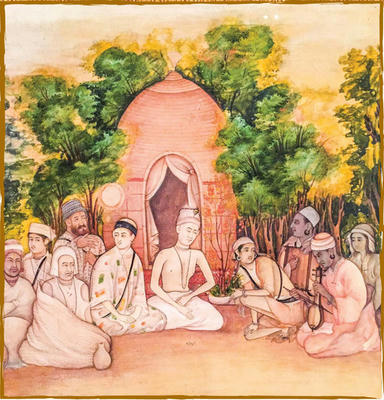
METROPOLITAN MUSEUM OF ART, MANHATTAN
Luminaries in conclave: This art is based on a well-known Mughal miniature from the 1650s on the theme of a gathering of holy men of Indian faiths. The main figures have been identified as Ravidas, Sena, Namdev, an Aughar, Kamal and Kabir. The work, by artist Mir Kalan Khan ca. 1770–75, hangs in the Metropolitan Museum of Art in Manhattan, New York.
With Kabir it’s much clearer. Here we have a flood of words that were remembered as his own in the sixteenth century itself. Some of them, we know, concern women—either to fend them off or to embrace what they stand for. But when Nabhadas praises Kabir in his Bhaktamal, we don’t hear about any of that.
AR: Would you like to add anything that we haven’t already talked about that you think is important with regard to Kabir?
JH: I can hear Kabir trying to shut me up.




